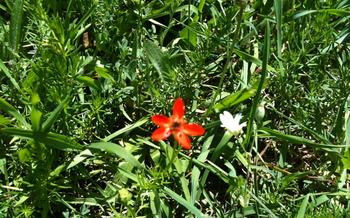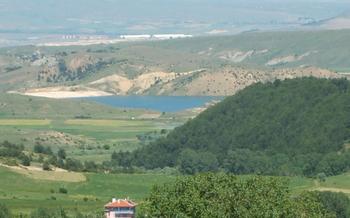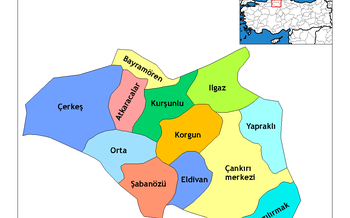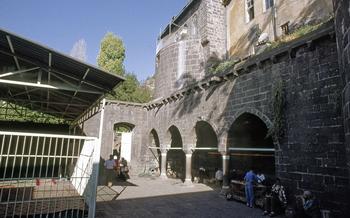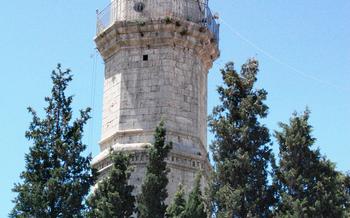
Çankırı Taş Mescit (Stone Mosque)
- The Mosque's Enduring Legacy
- Exploring the Mosque's Exterior
- Stepping Inside the Mosque
- The Mosque's Role in the Community
- Çankırı's Other Must-See Attractions
- Practical Tips for Visiting the Mosque
- Unveiling the Mosque's Architectural Secrets
- The Mosque's Spiritual Significance
- The Mosque and Local Craftsmanship
- The Mosque's Connection to the Natural World
- Insider Tip: Unveiling Hidden Treasures
The Mosque's Enduring Legacy
The Çankırı Stone Mosque stands as a testament to centuries of history, leaving an indelible mark on the city of Çankırı. Historical accounts and anecdotes recount the mosque's pivotal role in the community, serving as a place of worship, education, and social gatherings. Its presence has contributed significantly to Çankırı's identity, shaping the city's cultural and religious landscape. Stories of devotion and worship echo within the mosque's walls, narrating the lives of countless individuals who have found solace and guidance within its sacred spaces. Preservation efforts and renovations have ensured that the mosque's legacy continues to endure, showcasing the enduring spirit of this architectural gem. The Çankırı Stone Mosque remains a symbol of faith, resilience, and the enduring power of religious devotion.
Exploring the Mosque's Exterior
Çankırı's Stone Mosque stands as a testament to the city's rich history and architectural heritage. Its exterior, crafted from intricately carved stone, is a masterpiece of craftsmanship and artistry. The mosque's unique stonework, featuring delicate carvings and intricate patterns, sets it apart from other mosques in the region.
The mosque's harmonious blend with the surrounding environment is a testament to the architects' skill. The natural stonework complements the surrounding landscape, creating a sense of unity and balance. The interplay of natural light and shadows on the mosque's exterior adds to its visual appeal, casting dramatic shadows that change throughout the day.
Approaching the mosque, visitors are greeted by a grand entrance adorned with intricate carvings and calligraphy. The mosque's minaret, a slender tower that rises above the surrounding buildings, serves as a beacon, calling the faithful to prayer. The mosque's courtyard, surrounded by arched colonnades, provides a tranquil space for contemplation and reflection.
Overall, the exterior of Çankırı's Stone Mosque is a sight to behold, showcasing the city's rich cultural heritage and architectural prowess. The mosque's unique stonework, harmonious blend with the surroundings, and interplay of light and shadow create a captivating experience for visitors.
Stepping Inside the Mosque
As you step inside the Çankırı Taş Mescit, a sense of serenity and spirituality envelops you. The main prayer hall is a spacious and awe-inspiring chamber, characterized by its simple yet elegant design. The walls are adorned with intricate carvings and calligraphy, creating a visually captivating atmosphere.
The mihrab, the niche indicating the direction of Mecca, is a focal point of the mosque. It is intricately carved with geometric patterns and verses from the Quran, highlighting its religious significance. The minbar, the elevated pulpit from which the imam delivers sermons, is another notable feature, showcasing fine craftsmanship and attention to detail.
Other decorative elements, such as stained glass windows and hanging lamps, contribute to the mosque's ambiance. The natural light filtering through the windows casts beautiful shadows and reflections, creating a sense of tranquility and reverence within the prayer hall.
The mosque's interior spaces are not merely aesthetic but also hold profound religious and cultural significance. They provide a conducive environment for worship, contemplation, and spiritual connection, reflecting the mosque's role as a sacred space for the Muslim community.
The Mosque's Role in the Community
Beyond its religious significance, the Çankırı Taş Mescit has played a vital role in shaping the cultural and social fabric of the community. It serves as a place of worship and a center for religious gatherings, bringing people together for congregational prayers, festivals, and special occasions. The mosque has also been a center for education and learning, with classes and lectures on Islamic studies, Arabic language, and other subjects held within its walls.
Over the centuries, the mosque has hosted numerous social and cultural events, fostering a sense of community and belonging. Weddings, circumcision ceremonies, and religious celebrations have been held at the mosque, creating lasting memories and strengthening bonds among the residents of Çankırı. The mosque's courtyard and surrounding areas have served as venues for community gatherings, discussions, and charitable activities, further contributing to its role as a vibrant hub for social interaction.
The Çankırı Taş Mescit stands as a testament to the mosque's enduring role as a cornerstone of the community, serving as a place of worship, education, and social cohesion. Its legacy continues to inspire and unite the people of Çankırı, fostering a deep sense of shared identity and cultural heritage.
Çankırı's Other Must-See Attractions
In addition to the Çankırı Taş Mescit, the city boasts a wealth of other captivating attractions that showcase its rich history, natural beauty, and cultural heritage. History buffs can delve into the past at the Çankırı Museum, which houses a fascinating collection of artifacts and exhibits that narrate the city's intriguing story. For those seeking a glimpse into Çankırı's architectural legacy, the Grand Mosque, with its awe-inspiring dome and intricate tilework, stands as a testament to the city's artistic prowess.
Nature enthusiasts will find solace in the picturesque landscapes that surround Çankırı. The city's proximity to the Kızılcahamam National Park offers ample opportunities for hiking, picnicking, and wildlife spotting amidst stunning natural scenery. The sparkling waters of the Çankırı Dam provide a serene setting for leisurely walks, boat rides, and fishing escapades.
To immerse oneself in the vibrant cultural tapestry of Çankırı, a visit to the Çankırı Bazaar is a must. This bustling marketplace offers a kaleidoscope of colors, aromas, and sounds, where one can haggle for traditional handicrafts, savor delectable local cuisine, and experience the infectious energy of the city's vibrant commercial hub.
For those seeking a unique and immersive experience, a day trip to the nearby village of Ilgaz is highly recommended. Nestled amidst the majestic Ilgaz Mountains, this charming village offers breathtaking views, traditional Turkish hospitality, and a glimpse into the region's rural way of life.
Whether you're a history buff, nature lover, or cultural enthusiast, Çankırı promises an array of unforgettable experiences that will leave you spellbound.
Practical Tips for Visiting the Mosque
Before visiting the Çankırı Taş Mescit, it's essential to be mindful of the mosque's cultural and religious significance. Visitors are expected to dress modestly, with shoulders and knees covered. It's also important to be respectful of the worshippers and maintain silence while inside the mosque.
The mosque is open to visitors during non-prayer hours, typically from 9 am to 5 pm. It's advisable to check the mosque's official website or contact the local tourism office for specific visiting hours and any special arrangements.
Photography is generally allowed inside the mosque, but it's essential to be respectful and avoid using flash or disturbing worshippers. Visitors are encouraged to capture the mosque's beauty while maintaining the sanctity of the space.
By following these simple guidelines, visitors can ensure a meaningful and respectful experience while visiting the Çankırı Taş Mescit.
Unveiling the Mosque's Architectural Secrets
Beyond its religious significance, the Çankırı Stone Mosque stands as a testament to the ingenuity and craftsmanship of its builders. Constructed using unique techniques, the mosque showcases a blend of architectural styles that reflects the region's rich history. The mosque's design incorporates elements from Seljuk, Ottoman, and Byzantine architecture, creating a harmonious synthesis that is both aesthetically pleasing and historically significant.
The mosque's construction employed traditional methods, such as the use of cut stone blocks and intricate carvings. The stonework displays a remarkable level of precision and artistry, with each block carefully fitted together to form a sturdy and durable structure. The mosque's exterior is adorned with intricate carvings and decorations, showcasing the skill and dedication of the craftsmen who worked on its construction.
The mosque's interior spaces also reveal the architectural prowess of its builders. The main prayer hall is supported by a series of elegant columns, creating a sense of spaciousness and grandeur. The mihrab, the niche indicating the direction of Mecca, is intricately carved with geometric patterns and calligraphy, highlighting its importance as a focal point for prayer.
The mosque's construction and design played a crucial role in the development of Islamic architecture in the region. Its unique features and blend of architectural styles influenced the construction of subsequent mosques and religious structures in the area. The mosque's enduring legacy lies in its ability to showcase the evolution of Islamic architecture and its contribution to the region's cultural and historical heritage.
The Mosque's Spiritual Significance
Çankırı Taş Mescit stands as a testament to the enduring spiritual significance of religious architecture. Throughout history, the mosque has served as a sacred space for Muslims to gather for prayer, reflection, and contemplation. Its intricate design and serene atmosphere create an environment conducive to spiritual connection and communion with the divine.
The mosque's connection to Islamic history and traditions is deeply embedded in its design and symbolism. The orientation of the prayer hall towards Mecca, the presence of a mihrab indicating the direction of prayer, and the intricate carvings featuring verses from the Quran all contribute to the mosque's spiritual aura.
Beyond its physical structure, Çankırı Taş Mescit has played a vital role in shaping the city's spiritual landscape. For centuries, it has been a place where locals have come to seek solace, guidance, and a sense of community. The mosque's enduring presence has fostered a deep sense of devotion and spirituality among the people of Çankırı.
Personal stories and experiences of spiritual connection abound within the mosque's walls. Worshippers often speak of a sense of peace and tranquility that envelops them as they step inside. The mosque's serene atmosphere, combined with the melodious recitation of prayers and the collective energy of the congregation, creates a powerful and transformative spiritual experience.
Çankırı Taş Mescit's spiritual significance extends beyond its role as a place of worship. It serves as a reminder of the enduring power of faith and the importance of seeking spiritual fulfillment. The mosque's history, architecture, and the devotion of its worshippers all contribute to its status as a sacred and revered space, leaving a lasting impact on the hearts and minds of those who visit it.
The Mosque and Local Craftsmanship
The Çankırı Taş Mescit (Stone Mosque) stands as a testament to the exquisite craftsmanship and artistry of the local artisans and craftsmen who meticulously constructed this architectural masterpiece. Every intricate detail, from the intricate carvings that adorn the facade to the delicate patterns that grace the interior, showcases the exceptional skills and dedication of these talented individuals.
The mosque's construction employed traditional techniques and materials, such as finely cut stone, intricate tilework, and hand-carved woodwork. These elements harmoniously blend to create a visually stunning edifice that reflects the rich cultural heritage of Çankırı.
The mosque's minaret, a soaring testament to the builders' prowess, is adorned with intricate geometric patterns and elegant calligraphy, demonstrating the artisans' mastery of both form and function. The interior of the mosque is no less impressive, with its beautifully crafted mihrab (prayer niche) and minbar (pulpit), which feature intricate carvings and delicate inlay work.
The Çankırı Taş Mescit not only serves as a place of worship but also as a living testament to the enduring legacy of local craftsmanship. It stands as a reminder of the skill, dedication, and artistry that went into its creation, preserving the cultural heritage of Çankırı for generations to come.
The Mosque's Connection to the Natural World
The Çankırı Taş Mescit, a captivating architectural gem, harmoniously blends with its picturesque surroundings. Its design seamlessly integrates elements of the natural world, creating a spiritual sanctuary that resonates with the environment. The mosque's architects skillfully employed local materials, including stones quarried from the nearby hills, lending it an intrinsic connection to the region's geology. The strategic positioning of windows and openings allows natural light to filter into the prayer hall, casting beautiful shadows that dance upon the stonework, enhancing the mosque's serene atmosphere. The mosque's courtyard, a tranquil haven, features lush gardens adorned with native plants and flowers, fostering a sense of tranquility and communion with nature. This integration of natural elements not only enhances the mosque's aesthetic appeal but also reinforces its role as a sacred space that honors the harmony between faith and the environment.
Insider Tip: Unveiling Hidden Treasures
As you explore the Çankırı Taş Mescit, keep an eye out for hidden treasures that may not be immediately apparent. Look for intricate inscriptions and carvings that adorn the walls and columns, telling stories from the mosque's past. Some of these inscriptions may be difficult to decipher, but they offer a glimpse into the mosque's rich history.
In addition, inquire about the possibility of accessing exclusive areas or viewpoints that are not typically open to the public. The mosque's caretakers may be able to grant you special permission to visit these areas, providing you with a unique perspective on the mosque's architecture and design.
Finally, take the time to capture unique photos and memories of your visit. The mosque's intricate details and serene atmosphere make for stunning photographs. Experiment with different angles and lighting to capture the mosque's beauty from various perspectives. Your photos will serve as a lasting reminder of your time spent at this historic and awe-inspiring site.
